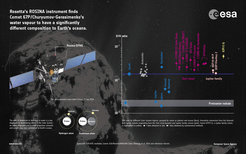Rosetta: Where does the water on Earth come from?
Measurements of the ESA-mission Rosetta show that the water vapour of the comet 67P/Churyumov-Gerasmenko is not similar to the water on Earth.
New measurement data from the ESA-mission Rosetta raises doubts on the theory that comets once provided the Earth with water. An international research team led by the University of Bern investigated the water vapour from the environment of Rosetta’s comet 67P/Churyumov-Gerasimenk with the help of the mass spectrometer ROSINA. The composition is not similar to earthly water. After the comet Halley, Rosetta’s comet is the second comet for which such measurements were performed locally instead of from a far distance. The Max Planck Institute for Solar System Research (MPS), being a member of the ROSINA collaboration, has contributed decisive hardware components to the building of the instrument.
Hardly any other chemical compound seems to be as characteristic for our blue planet as water. However, it is an immigrant: In the early phase of the solar system volatile substances evaporated from the inner planetary system and were only accumulated far away from the sun beyond the orbit of Mars. The question researchers try to answer is how the water returned later. To do so they look at the molecular structure of water since not all water molecules are the same. One molecule with the hydrogen atom replaced by the heavier isotope deuterium faces 6400 “normal” representatives of the molecule on earth. “This proportion could give us information about the origin of the earthly water”, explain Axel Korth and Urs Mall who work at the MPS and are co-authors of the new study. “We are aiming to find bodies in the solar system which have similar values.”
For a long time only asteroids circling between the orbits of Mars and Jupiter around the Sun, which means that they are relatively close to Earth, have been considered. Recently, groups of researchers discovered that the two short-period comets 103P/Hartley 2 and 45P/Honda-Mrkos-Pajdušáková contain water which is similar to that on Earth. The so-called Kuiper Belt, which is a region beyond the orbit of the Neptune, was regarded as the place of origin of these bodies until now. The Rosetta comet 67P/Churyumov-Gerasimenko is also part of this family of comets. Nevertheless the relation of deuterium and hydrogen, which was now found by researchers of the University of Bern led by Kathrin Altwegg, does not fit in with the values of 67P’s comical siblings. Each deuterium atom of Rosetta’s comet only faces about 1880 normal hydrogen atoms.

This value raises several basic questions. Researchers suppose that deuterium was spread following a simple rule in the early phase of our planetary system: the farther an object was located away from the Sun the more deuterium was present in comparison with normal hydrogen. Measurements of asteroids and long period comets like Halley used to fit into this picture. However, the values of 103/P Hartley 2 and 45P/Honda-Mrkos-Pajdušáková which are similar to values on Earth caused confusion.
“Comet 67P fits quite well into the general theory”, says Mall, “but the representatives of this family of comets obviously form a heterogeneous group.” The researchers conclude from their results that possibly not all short period comets originate from the Kuiper Belt as previously assumed. Some of them like 103P/Hartley 2 and 45P/Honda-Mrkos-Pajdušáková could possibly have been asteroids that were diverted to comet-like orbits much later. Therefore water which is similar to that on Earth would still be reserved to asteroids – and these bodies would consequently be the major candidates for the cosmic supply of water to Earth.
The mass spectrometer ROSINA (Rosetta Orbiter Spectrometer for Ion and Neutral Analysis), which is one out of ten scientific instruments of the Rosetta-Orbiter, was responsible for the new measurements. ROSINA was able to measure the water vapour from 67P/Churyumov-Gerasimenko between August 8 and September 4, 2014 and consequently detect seldom isotopes with the help of its high sensibility.
“A measurement of this kind which determines the relation of deuterium to hydrogen directly in a comet’s coma took place 28 years earlier far away from the comet Halley”, explains Korth. At that time ESA’s space probe Giotto rushed past the comet at a distance of less than 600 kilometers. While flying by, the mass spectrometer on board “sniffed” at the comet’s water vapour. In all other cases, in which the relation of deuterium to hydrogen is known, the value was defined from a greater distance and consequently by indirect measurements.
“However, the recent results are a snapshot” considers Mall. He says it would be possible that the measurements which will be performed in the following months deliver different values. Unlike Giotto and previous comet-missions, Rosetta offers the opportunity to accompany the comet on its way to the Sun and to monitor how it changes. The increasing activity of 67P could also have effects on the composition of the water vapour.
Rosetta is an ESA mission with contributions from its member states and NASA. Rosetta's Philae lander is provided by a consortium led by DLR, MPS, CNES and ASI. Rosetta will be the first mission in history to rendezvous with a comet, escort it as it orbits the Sun, and deploy a lander to its surface.
The instrument package ROSINA (Rosetta Orbiter Spectrometer for Ion and Neutral Analysis) was developed and built by an international consortium led by the Space Research and Planetary Sciences Division of the University of Bern. The University of Bern provides the Principal Investigator of the ROSINA team, Kathrin Altwegg. The hardware components have been provided by the Belgian Institute for Space Aeronomy (Brussels, Belgium), the Research Institute in Astrophysics and Planetology (Toulouse, France), the Institute Pierre Simon Laplace (Paris, France), the Lockheed Martin Advanced Technology Center (Palo Alto, USA), the Max Planck Institute for Solar System Research (Goettingen, Germany), the Institute of Computer and Network Engineering at the TU Braunschweig (Braunschweig, Germany) und der University of Michigan (Ann Arbor, USA).
